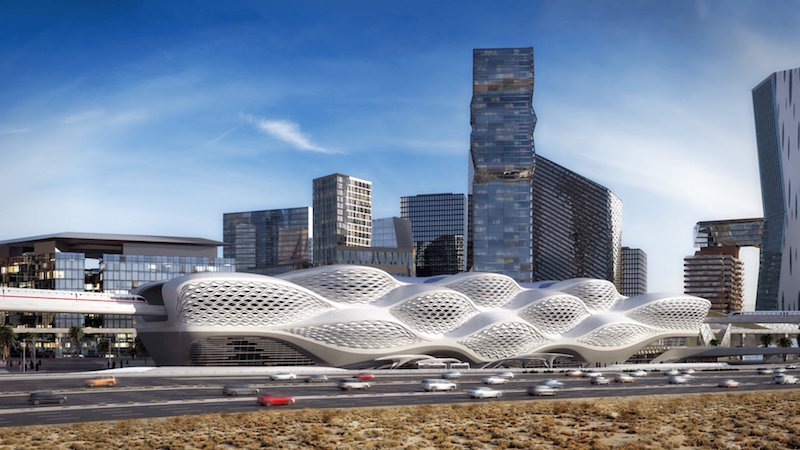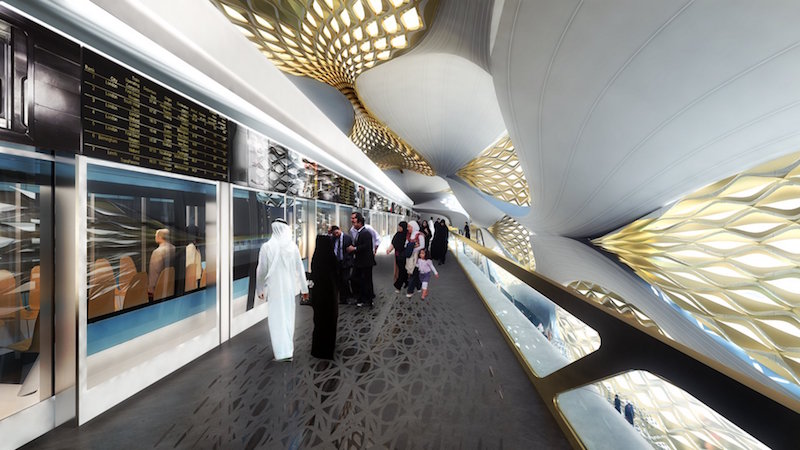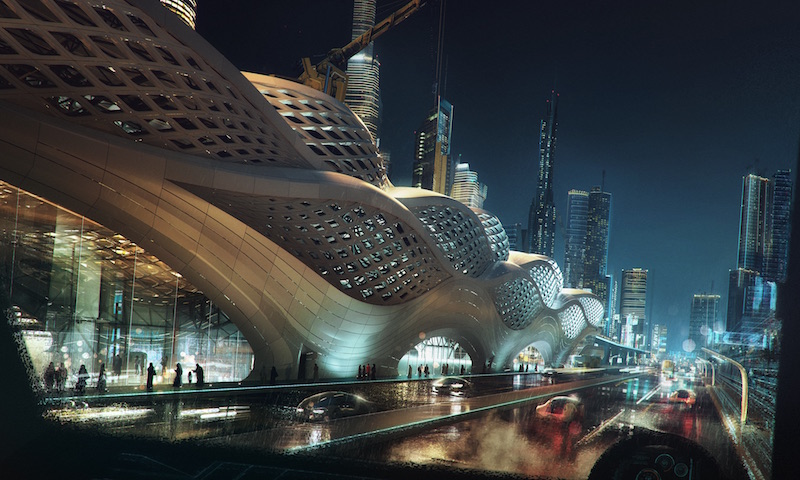Designed by Zaha Hadid Architects, the new King Abdullah Financial District (KAFD) Metro Station in Riyadh, Saudi Arabia will serve as a key interchange on the new Riyadh Metro network for Line 1 and the terminus of Line 4 and Line 6.
The 45,000-sm complex will include four above ground levels and two below ground (car parking) and will be integrated within the urban context of the financial district. The most striking feature of the new metro station is the façade, meant to represent patterns generated by desert winds.
 Courtesy ZHA.
Courtesy ZHA.
The façade is design-engineered by Newtecnic to reduce solar gain and produce air currents that help cool the building. The firm’s research team had to develop new algorithms to achieve this level of performance. Additionally, Newtecnic had to invent new adjustable building components and fixing methods for the structure’s self-supporting, 650-foot-long concrete-composite walls and roof.
The result of this world-first-façade and the new techniques used to create it is an undulating, futuristic building that will be delivered for the price of a more traditional structure and last twice as long.
 Courtesy ZHA.
Courtesy ZHA.
The KAFD Metro Hub is designed to support Riyadh’s expected 50% growth over the coming years and is part of a new citywide transport system that comprises six metro line, 85 stations, and more than 100 miles of track.
BACS Consortium is the general contractor for the project, which is slated for completion in 2018.
 Courtesy ZHA.
Courtesy ZHA.
Related Stories
| May 13, 2014
19 industry groups team to promote resilient planning and building materials
The industry associations, with more than 700,000 members generating almost $1 trillion in GDP, have issued a joint statement on resilience, pushing design and building solutions for disaster mitigation.
| May 11, 2014
Final call for entries: 2014 Giants 300 survey
BD+C's 2014 Giants 300 survey forms are due Wednesday, May 21. Survey results will be published in our July 2014 issue. The annual Giants 300 Report ranks the top AEC firms in commercial construction, by revenue.
| May 1, 2014
Super BIM: 7 award-winning BIM/VDC-driven projects
Thom Mayne's Perot Museum of Nature and Science and Anaheim's new intermodal center are among the 2014 AIA TAP BIM Award winners.
| Apr 29, 2014
USGBC launches real-time green building data dashboard
The online data visualization resource highlights green building data for each state and Washington, D.C.
Smart Buildings | Apr 28, 2014
Cities Alive: Arup report examines latest trends in urban green spaces
From vertical farming to glowing trees (yes, glowing trees), Arup engineers imagine the future of green infrastructure in cities across the world.
| Apr 9, 2014
Steel decks: 11 tips for their proper use | BD+C
Building Teams have been using steel decks with proven success for 75 years. Building Design+Construction consulted with technical experts from the Steel Deck Institute and the deck manufacturing industry for their advice on how best to use steel decking.
| Apr 2, 2014
8 tips for avoiding thermal bridges in window applications
Aligning thermal breaks and applying air barriers are among the top design and installation tricks recommended by building enclosure experts.
| Mar 26, 2014
Free transit for everyone! Then again, maybe not
An interesting experiment is taking place in Tallinn, the capital of Estonia, where, for the last year or so, its 430,000 residents have been able to ride the city’s transit lines practically for free. City officials hope to pump up ridership by 20%, cut carbon emissions, and give low-income Tallinnites greater access to job opportunities. But is it working?
| Mar 26, 2014
Callison launches sustainable design tool with 84 proven strategies
Hybrid ventilation, nighttime cooling, and fuel cell technology are among the dozens of sustainable design techniques profiled by Callison on its new website, Matrix.Callison.com.
| Mar 20, 2014
Common EIFS failures, and how to prevent them
Poor workmanship, impact damage, building movement, and incompatible or unsound substrate are among the major culprits of EIFS problems.

















